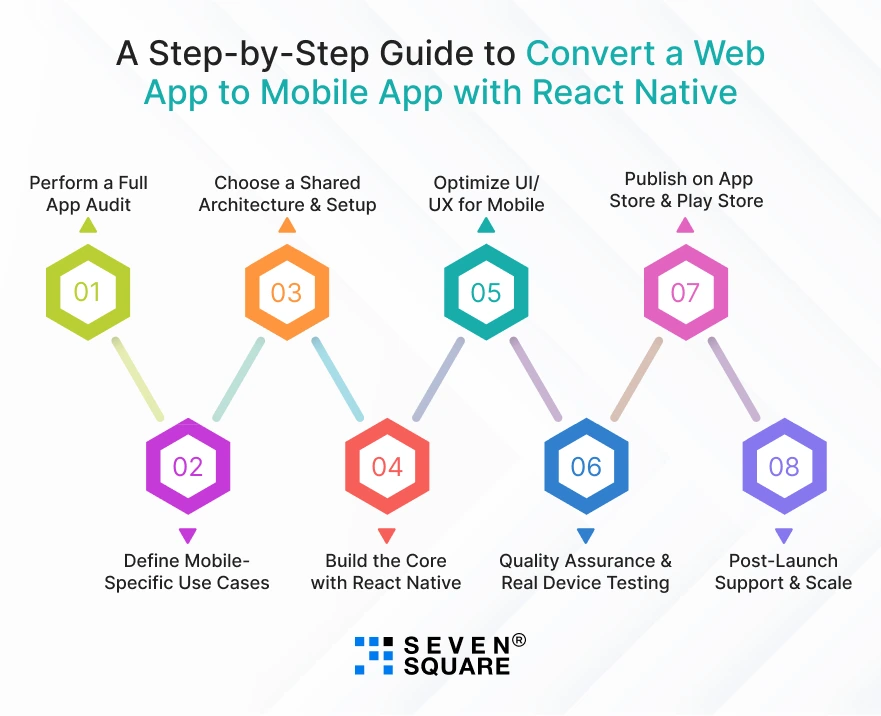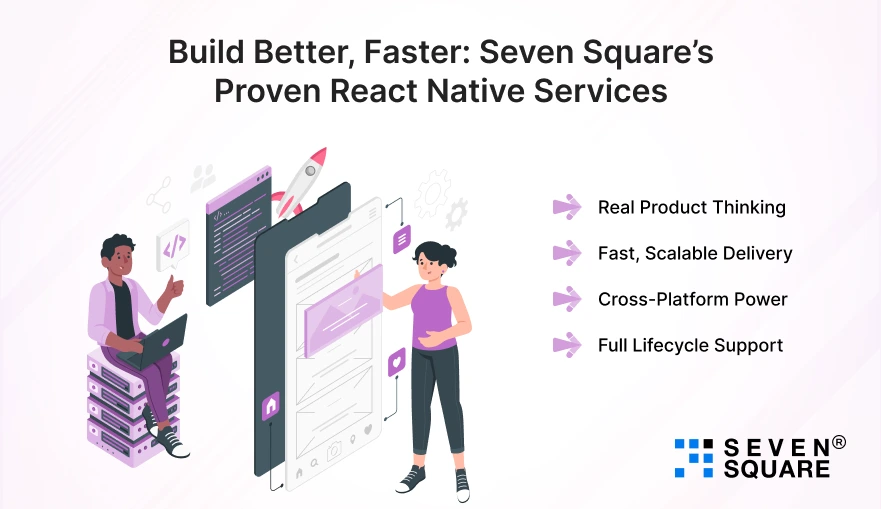Your web app is gaining popularity. Traffic’s growing, feedback’s solid, and your users keep asking one thing: “When are you launching a mobile app?”
You’ve thought about it, even explored a few options, but here’s the challenge: building native apps from scratch is expensive, time-consuming, and means doubling the work.
We’ve seen this happening with many businesses. And our development team helped founders convert web apps to mobile apps using React Native.
You want a faster route to mobile. A real mobile app experience that is delivered fast, built right, and designed to scale.
This is where React Native migration services come into the picture.
It is the best way to convert web app to mobile app. If you are trying to learn about web app to mobile conversion, this blog is for you.
Why Founders Are Moving from Web to Mobile Faster Than Ever?
Users today expect mobile-first experiences. They want fast-loading, touch-optimized, native-feeling apps they can access anywhere.
If your web app isn’t mobile-optimized or lacks a native counterpart, you’re likely losing users.
The Signals You Shouldn’t Ignore:
- Mobile traffic is overtaking desktop traffic.
- Customers are requesting a mobile version.
- High drop-off on the web when accessed via mobile.
- Competitors are launching mobile-first features.
React Native lets you bridge that gap faster.
With it, you’re not building two apps; you’re building one cross-platform mobile app with shared logic, near-native performance, and faster go-to-market.
And you don’t need to start from scratch. If you’ve already built a solid product on the web, we help you migrate it smartly to mobile.
Why React Native for Web-to-Mobile App Conversion?
We’ve worked with different types of teams choosing React Native for web-to-mobile migration, and here’s why it works:
1. Shared Codebase, Faster Delivery
- React Native allows you to reuse up to 90% of your business logic and UI components, especially if your web app is built with React.js.
- This means shorter development cycles and less maintenance.
2. Cross-Platform App Development That Feels Native
- Whether it’s Android or iOS, you get native performance with fewer platform-specific issues.
- Our clients have seen up to 40% savings in development effort compared to building separately.
3. Cost-Effective Hybrid App Development
- You don’t need two separate dev teams.
- Just one. That’s why startups and scale-ups alike are moving to hybrid app development using React Native.
4. Future-Proof & Community-Backed
- React Native is backed by Meta and used by giants like Instagram, Shopify, and Tesla.
- With regular updates, thousands of contributors, and enterprise-grade plugins, it’s built to last.
5. Perfect Fit for MVPs and Full-Scale Products
- Whether you’re testing mobile waters or expanding your reach, React Native is perfect for both MVPs and enterprise-grade apps.
A Step-by-Step Guide to Convert a Web App to Mobile App with React Native

Here’s our real-world approach to React Native migration services, the same one that’s worked across industries like healthcare, retail, and fintech.
If you’re looking to convert a web app to mobile app using React Native, here’s the complete step-by-step guide:
Step 1: Perform a Full App Audit
- We begin with a technical audit of your existing web application.
- This includes identifying reusable business logic, shared UI components (especially if built with React.js), and understanding API dependencies.
- This step is critical to optimizing your React Native migration without rebuilding the wheel.
Step 2: Define Mobile-Specific Use Cases
- Mobile apps are not a 1:1 clone of your web app.
- We work closely with your team to define how your web app to mobile conversion should behave, focusing on touch-optimized UI, gesture support, offline mode, and native features like push notifications and geolocation.
- This ensures your users get a native-like experience using React Native app development.
Step 3: Choose a Shared Architecture & Setup
- We structure your codebase to separate shared logic from mobile-specific views.
- If you’re using React.js, we help extract the shared components into a common package.
- Then, we set up your mobile environment using React Native CLI or Expo, depending on your app’s complexity and deployment needs.
Step 4: Build the Core with React Native
- This is where we begin to convert your web app into a mobile app.
- Using the shared logic, we build mobile interfaces using React Native components like View, Text, TouchableOpacity, etc.
- This step includes mobile navigation with React Navigation and state management using Redux, Recoil, or Context API.
- We also consider platform-specific customizations for Android and iOS while maintaining maximum code reusability and true cross-platform app development.
Step 5: Optimize UI/UX for Mobile
- The desktop-first design won’t work out.
- We reimagine screens with mobile patterns like bottom tab bars, collapsible headers, swipe gestures, and smaller touch targets.
- Our team uses Figma and mobile-first UI libraries to create touch-optimized designs that elevate user experience.
Step 6: Quality Assurance & Real Device Testing
- We test extensively using emulators and real devices.
- Our QA team checks compatibility, performance, edge cases, and UX consistency across Android and iOS.
- We also set up tools like Detox and Appium for automated testing to improve launch reliability.
Step 7: Publish on App Store & Play Store
- Once we’re satisfied with testing, we build release versions, handle certificates and provisioning profiles, and publish your app to the stores.
- We guide you through app review processes and resubmissions.
Step 8: Post-Launch Support & Scale
- After going live, we track analytics, performance, and user feedback.
- We provide ongoing support for crash logs, OS upgrades, and new features to help your product evolve.
- This full-cycle support is what makes us a trusted React Native migration partner.
What Are the Common Migration Pitfalls? And How We Help You Avoid Them?
Here you can see some of the most common React Native migration services that you should avoid.
Mistake 1: Wrapping a Web App with WebView
- Sounds easy. Works badly.
- Wrapping your web app in a WebView just to “make it mobile” leads to poor performance, no native access, and a bad user experience.
- We use React Native WebView wrapper only where it makes sense, not as the core.
Mistake 2: Copy-Pasting Desktop Features
- Mobile users tap, swipe, speak; they don’t click and scroll like desktop users.
- We help redesign the UX to match mobile behavior.
Mistake 3: Ignoring Backend Optimization
- Your backend might be tuned for web, but mobile needs faster APIs, caching, and offline support.
- We optimize backend interaction as part of our migration services.
Build Better, Faster: Seven Square’s Proven React Native Services

At Seven Square, we don’t just migrate your web app; we help you launch mobile products that perform, scale, and delight users.
Whether you’re looking to convert a web app to a mobile app with React Native or need a full-cycle hybrid app development partner, we’ve got you covered.
Here’s why founders across industries choose us:
- Real Product Thinking: Our team of experienced developers brings clarity, speed, and product-first thinking to every project.
- Fast, Scalable Delivery: We build fast, but never compromise. Our React Native migration services are customized for speed, scale, & long-term maintainability.
- Cross-Platform Power: We deliver truly cross-platform mobile apps that feel native on both iOS and Android, using React Native’s shared logic and performance optimization.
- Full Lifecycle Support: From mobile UI/UX to API optimization and post-launch analytics, we support you at every step of your web app to mobile conversion journey.
Want to Convert your Web App to a Mobile App with React Native? Contact Us Now!
What Does It Cost to Convert Web App to Mobile App? (React Native Edition)
Pricing depends on:
- Size and complexity of your web app.
- Mobile-specific features needed.
- Whether we can reuse code from your existing app.
Typical ranges:
- MVP: $3,000 to $5,000
- Full-scale product: $5,000 to $10,000
We’ve helped startups reduce development costs by 35% through smart reuse and modular architecture.
Go Mobile the Smart Way
Migrating from web to mobile isn’t just a tech move; it’s a product decision.
Done right, it helps you reach more users, improve retention, and stand out in a crowded market.
With React Native, you get the speed, scalability, and quality you need.
With Seven Square, you get a development team that’s done this before for startups and enterprises alike.
FAQs
- Yes, React Native is one of the best frameworks for web app to mobile conversion.
- It allows you to reuse up to 90% of your existing code, supports both iOS and Android platforms, and delivers a near-native user experience.
- This makes it ideal for startups and enterprises looking for efficient React Native migration services.
- React Native hybrid app development offers benefits like reduced development time, lower costs, shared codebases across platforms, and access to native features.
- It’s perfect for converting web apps to mobile apps without building separate native apps for each OS.
- Important mobile features include native navigation, offline mode, push notifications, GPS access, camera integration, and touch-optimized UI.
- When we convert your web app to mobile using React Native, we prioritize these features for an optimal mobile experience.
- No. React Native supports cross-platform app development, which means you can build one mobile app for both iOS and Android using a single codebase.
- It’s efficient, cost-effective, and great for scaling your product across devices.